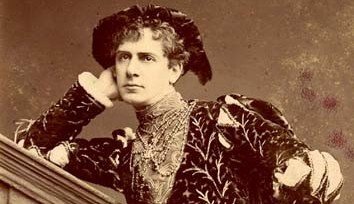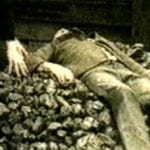 Weird Stuff
Weird Stuff  Weird Stuff
Weird Stuff  Miscellaneous
Miscellaneous Top 10 Things Crypto Was Supposed to Change & What Actually Did
 History
History 10 Huge Historical Events That Happened on Christmas Eve
 Music
Music 10 Surprising Origin Stories of Your Favorite Holiday Songs
 History
History 10 Less Than Jolly Events That Occurred on December 25
 Weird Stuff
Weird Stuff 10 Funny Ways That Researchers Overthink Christmas
 Politics
Politics 10 Political Scandals That Sent Crowds Into the Streets
 Weird Stuff
Weird Stuff Ten Bizarre Facts About The Doge Meme
 Our World
Our World 10 Ways Your Christmas Tree Is More Lit Than You Think
 Movies and TV
Movies and TV The 10 Coolest Stars to Set Sail on The Love Boat
 Weird Stuff
Weird Stuff 10 Fascinating Facts You Might Not Know About Snow
 Miscellaneous
Miscellaneous Top 10 Things Crypto Was Supposed to Change & What Actually Did
 History
History 10 Huge Historical Events That Happened on Christmas Eve
Who's Behind Listverse?

Jamie Frater
Head Editor
Jamie founded Listverse due to an insatiable desire to share fascinating, obscure, and bizarre facts. He has been a guest speaker on numerous national radio and television stations and is a five time published author.
More About Us Music
Music 10 Surprising Origin Stories of Your Favorite Holiday Songs
 History
History 10 Less Than Jolly Events That Occurred on December 25
 Weird Stuff
Weird Stuff 10 Funny Ways That Researchers Overthink Christmas
 Politics
Politics 10 Political Scandals That Sent Crowds Into the Streets
 Weird Stuff
Weird Stuff Ten Bizarre Facts About The Doge Meme
 Our World
Our World 10 Ways Your Christmas Tree Is More Lit Than You Think
 Movies and TV
Movies and TV The 10 Coolest Stars to Set Sail on The Love Boat
10 Strange Unsolved Train Mysteries
One of the most bizarre unsolved disappearances of all time involves renowned French inventor Louis Le Prince. In 1890, while on a train heading to Paris, Le Prince somehow vanished without a trace and was never seen again. The story was particularly puzzling since nobody could figure out how a man could simply disappear from a moving train. However, rail transport and rapid transit has long been the source of some truly baffling unsolved mysteries, whether they be unexplained disappearances, murders, derailments, or even bizarre supernatural occurrences.
10The Sunset Limited Derailment

On October 9, 1995, an Amtrak passenger train known as the Sunset Limited was making a routine trip from Los Angeles to Miami. At approximately 1:40 AM, it was crossing over a trestle in a remote desert area of Arizona when it suddenly jumped the tracks and derailed, sending four of its cars crashing 9 meters (30 ft) into a ravine. An attendant named Mitchell Bates was killed in the crash and over 100 people were injured.
It quickly became clear that the derailment was a deliberate act of sabotage—29 spikes had been removed from the track so that the rails could be shifted out of position. The perpetrator was careful to keep the rail’s signal circuits intact, so that the train would not be alerted about any problems with the track. This suggested that whoever was responsible had an intimate knowledge of railroads.
In fact, the method used to derail the Sunset Limited was very similar to an act of sabotage from 1939, which caused a passenger train called the City of San Francisco to derail in the Nevada desert, killing 24 people. An article about the City of San Francisco crash had been published in a train journal shortly before the Sunset Limited derailment and may have inspired the perpetrator.
At the crash site, investigators found four typewritten copies of a note claiming responsibility for the attack. The notes were signed “Sons of the Gestapo” and criticized controversial incidents involving the ATF and FBI, such as the Ruby Ridge siege of 1992 and the Waco siege of 1993. However, investigators have yet to uncover any evidence supporting the actual existence of a group known as “Sons of the Gestapo.” The perpetrator remains unidentified.
9The Murder Of Rashawn Brazell

On the morning of February 14, 2005, 19-year-old Brooklyn resident Rashawn Brazell failed to show up for any of his scheduled appointments. Witnesses would later report seeing Rashawn outside his apartment at approximately 7:30 AM, after an unidentified man rang the buzzer. Rashawn was then seen entering the Gates Avenue subway station with the man. There were also unconfirmed sightings of the two men at the Nostrand Avenue station later that day. In the early morning hours of February 17, transit workers at the Nostrand station found two bags next to the subway tracks. One of them contained some tools and bloody drill bits. The other contained some of the dismembered remains of Rashawn Brazell.
Over the next few days, more of Rashawn’s body parts would be discovered in trash bags at a local recycling plant. His head was never found. A medical examination concluded that Rashawn was likely alive for two days following his disappearance, so he may have undergone torture before his death. Since Rashawn was known to be homosexual, there was some speculation that his murder was a hate crime, but no evidence could be found to support this theory.
However, there was one intriguing clue in the form of the bag containing the bloody drill bits, which was a type sold exclusively to employees of the Metropolitan Transit Authority. Since Rashawn’s remains were discovered in an area of the subway station usually only frequented by employees, it’s been theorized that the killer might be a transit worker. It’s unknown if Rashawn’s killer is the same man seen with him outside his apartment, and an investigation has so far failed to turn up any solid suspects.
8The St. Louis Ghost Train
For the past century, the village of St. Louis, Saskatchewan, has been notable for a supernatural phenomenon known as the “St. Louis Ghost Train.” At an old railway crossing located outside the village, witnesses have long reported seeing what appears to be a train light in the distance, which appears out of nowhere and gradually moves toward them. It is usually accompanied by a smaller red light, and both will disappear without explanation before reaching the railway crossing.
According to local legend, a conductor was once decapitated by a train on that very stretch of track, leading to the belief that the large light represents the train and the red light represents a lantern being carried by the headless conductor’s ghost. Although the line has now been abandoned for over 30 years, and the tracks are no longer there, the ghostly lights continue to make appearances.
Recently, two local high school students attempted to solve the mystery as part of a science fair project. They waited by the railway crossing while one of their fathers flashed his car headlights from various locations in the distance. When the car was on a hilltop highway 8 kilometers (5 mi) away, both students saw lights resembling the Ghost Train. They theorized that the vehicle’s lights were enhanced by an optical phenomenon known as diffraction.
While the students wound up winning an award at the science fair, many residents do not believe their theory debunks the mystery, since reports of the Ghost Train date back to before automobiles were even used in the region.
7The Disappearance Of Martin Allen

On the afternoon of November 5, 1979, 15-year-old Martin Allen finished school and spent some time hanging around London’s King’s Cross station with his friends, before eventually hopping on a train home. He never arrived and was soon reported missing. A witness later recalled seeing a nervous-looking boy resembling Martin in the company of an unidentified man at Gloucester Road station that same day. The man was holding the boy’s shoulder and warning him not to run away.
Over the years, there have been very strange developments in this case. In 1998, a shrine to Martin Allen was found inside the home of an alleged pedophile. This person matched the description of the man last seen with Martin, but authorities could not connect him to the disappearance.
Martin’s family believe there is a massive cover-up surrounding his case. In recent years, they were informed that files and evidence related to Martin’s disappearance were destroyed in a flood, and that a police officer inexplicably took some other files with him when he retired and moved to Spain.
It has been speculated that Martin’s disappearance may be connected to an scandal involving an organized pedophile ring, in which children were allegedly delivered to high-profile figures at a brothel known as the Elm Guest House during the 1970s and ’80s. One anonymous witness came forward to claim he was a victim of the ring and had been molested by an MP during his childhood. He also claims to have personally witnessed the murder of three other boys, one of whom may have been Martin. In spite of these allegations, Martin Allen’s disappearance remains unsolved.
6The Disappearance Of Jesus De Galindez

Born in Spain, Jesus de Galindez lived in the Dominican Republic for six years before moving to New York City in 1946. He became a political science professor at Columbia University and worked on a doctoral dissertation denouncing the brutal practices of Dominican dictator Rafael Trujillo. Trujillo reportedly had his agents offer Galindez $25,000 to discard the dissertation, but Galindez refused.
On the evening of March 12, 1956, Galindez finished teaching a class at Columbia and accepted a ride from one of his students to the subway station at 57th Street and 8th Avenue. After Galindez entered the station, he was never seen again.
Nine months later, Galindez’s case was connected to another strange disappearance when the abandoned car of an American pilot named Gerald Murphy was discovered next to a seaside cliff near the capital of the Dominican Republic. By this point, an investigation had uncovered evidence that Galindez had been abducted from the subway and put on a plane flown by Murphy and another pilot named Octavio de la Maza. Galindez was subsequently delivered to Rafael Trujillo, who ordered his execution. Murphy had allegedly leaked details about his involvement in the Galindez disappearance to his fiancee, and it wasn’t long before he also went missing.
Even though Murphy’s body was never found, the Dominican government arrested Octavio de la Maza for his murder. In January 1957, de la Maza was found hanging in his cell, leaving behind a suicide note in which he confessed to pushing Murphy off a cliff. Unsurprisingly, most people believe the note was a forgery. Even though Jesus de Galindez was never found, the story ended with some poetic justice when de la Maza’s brother participated in Trujillo’s assassination in 1961.
5The Murder Of Seymour Barmore

In 1868, a Cincinnati private investigator named Seymour Barmore was brought to Nashville for an unusual assignment from Tennessee governor William Gannaway Brownlow. Following the US Civil War, the Klu Klux Klan had been carrying out acts of terrorism and murder as part of their resistance to Reconstruction. Brownlow charged Barmore with infiltrating the KKK and passing information back to the authorities.
Barmore accepted the assignment, but it wasn’t long before the Klan figured out he was a mole. Barmore was abducted from a train by several Klansmen, held captive overnight, and warned to back off. Nevertheless, Barmore was determined to finish his assignment.Two days later, he took a train to Pulaski and infiltrated a secret KKK meeting there. He then proceeded to hop on a late-night train to Nashville, but the train came to an abrupt stop near Columbia. Over a dozen masked Klansmen proceeded to board Barmore’s car and abduct him a second time.
This time, Barmore would be hanged and shot several times before his body was dumped in the Duck River. It was rumored that Barmore had been carrying a notebook containing the identities of several prominent Tennessee Klansmen, but it disappeared after his death. It was also believed that many of the crew members of Barmore’s train were Klansmen and had been warned to stop for his abduction. Even though there was no doubt that members of the Klu Klux Klan were responsible for Barmore’s murder, their identities were never revealed and no one was ever prosecuted.
4The Ghost Of William Terriss

In November 1955, Jack Hayden, a ticket taker at London’s Covent Garden tube station, was locking up for the night when he encountered an elegantly dressed man, complete with gloves and a cane. After Hayden unlocked the gate to let the man out, he mysteriously disappeared.
Four days later, Hayden saw the same man on a staircase, but he once again disappeared when Hayden called out to him. Two more employees soon reported seeing the ghostly figure. When Hayden provided a description to a sketch artist, it led to a photograph of a man who was a dead ringer for the specter. It was William Terriss, one of England’s most popular stage actors during the late 19th century. Over the next two decades, there would several more sightings of a figure resembling Terriss inside Covent Garden station.
The ghost of William Terriss is also believed to haunt the nearby Adelphi Theatre. On December 16, 1897, Terriss was playing the lead in a production there, but when he showed up that night, he was stabbed to death by fellow actor Richard Archer Prince, whom Terriss had previously had fired from another production. Prince was known to be a mentally unstable alcoholic and the two men had a number of heated confrontations in the days before the murder. At his trial, Prince was declared to be insane and sent to a lunatic asylum, where he would spend the last 40 years of his life performing in productions for the inmates’s theatrical society.
At the time, many people felt that Prince got off easy, which might explain why Terriss’s restless spirit returned to haunt London. Even though Covent Garden station did not exist when Terriss was alive, it is theorized that he haunts the place because it was built on the former site of his favorite bakery.
3The Disappearance Of Robin Putnam

In 2012, Robin Putnam was a 25-year-old student at the California College of the Arts in Oakland. On July 7, Robin boarded an Amtrak train for a trip to see his family in Grand Junction, Colorado. At approximately 3:00 AM, the train made a scheduled stop in Salt Lake City, where it remained for 25 minutes before completing the journey to Grand Junction. But when the train arrived, Robin Putnam was no longer on it. All of his belongings, including his wallet, journal, and laptop, were still in his seat, but Robin himself was nowhere to be found.
It’s likely that Robin got off the train during the stop in Salt Lake City, but no one knows what happened to him afterward. Before his trip, Robin had been displaying bizarre, erratic behavior, and suffering anxiety attacks, which forced him to quit his job at a coffee shop. He had apparently not slept in several days. On one occasion, he awoke from a terrible nightmare and seemed to have trouble telling his dreams from reality.
Even though Robin didn’t display any strange behavior while on the train, it’s theorized that he may have became disoriented when they arrived in Salt Lake City. There have been unconfirmed sightings of Robin in the area, and two months after his disappearance, a man matching his description was seen in a security video at a Salt Lake City restaurant, drinking a beer with an unidentified woman. His current whereabouts remain a mystery.
2The Disappearance Of Andrew Gosden

One of the strangest British missing persons cases of recent memory involves a 14-year-old boy named Andrew Gosden. In 2007, Andrew lived with his parents and sister in Doncaster. On the morning of September 14, he seemingly left for school as usual. But he never arrived and his parents realized something was very wrong when they discovered his school uniform in his bedroom later that day.
Apparently, after his family left the house that morning, Andrew returned home to change his clothes. He then emptied his bank account of £200 before arriving at Doncaster station, where he purchased a train ticket to King’s Cross station in London. He would be captured on CCTV footage there at approximately 11:20 AM. That was the last confirmed sighting of him.
Since Andrew had no known problems, his family were completely baffled by his inexplicable decision to travel to London. He left no note behind to explain his actions and took very few items with him. The strangest detail is that Andrew insisted on purchasing a one-way train ticket, even after he was informed that a return ticket would only cost £1 more.
One year after Andrew’s disappearance, an unidentified man spoke into the intercom at the doorway to Leominster Police Station in Hertfordshire, claiming to have information about the case. When an officer arrived to answer the door, the man had disappeared. After more than seven years, there is still no trace of Andrew Gosden or any explanation for his mysterious train trip.
1The Japanese National Railways Incidents

During the summer of 1949, the city of Tokyo experienced three mysterious incidents involving Japanese National Railways (JNR). After he was appointed president of JNR, Sadanori Shimoyama was tasked with firing thousands of employees, many of whom were believed to be affiliated with the Japanese Communist Party. On July 5, Shimoyama was on his way to his office when he stopped at a department store. He never returned to his vehicle, and his mangled body was found on some tracks the following morning. He had been run over by a train, but it was impossible to tell if his death was murder or suicide. Ten days later, an unmanned JNR train was deliberately crashed into Mitaka station, killing six people and injuring 20 others.
Ten JNR union members were indicted for sabotage, as authorities believed the incident was retaliation for the upcoming job cuts. Only one suspect, Keisuke Takeuchi, would be convicted after he confessed to the crime. Once he had been given a life sentence, Takeuchi recanted his confession and maintained his innocence until his death in 1967. His family has continually fought to clear his name and newly uncovered evidence suggests that he was in a bathhouse at the time of the crash.
On August 17, another JNR train derailed near Matsukawa station after joints and spikes were removed from the track, causing the deaths of three crewmen. Once again, 20 JNR union activists, many of them affiliated with the Communist Party, were accused of orchestrating the crash. However, as the years went on, their convictions were all overturned. Now, many people believe that all three JNR incidents were orchestrated by the authorities as part of a conspiracy to discredit the Communist-leaning union.
Robin Warder is a budding Canadian screenwriter who has used his encyclopedic movie knowledge to publish numerous articles at Cracked.com. He is also the co-owner of a pop culture website called The Back Row and recently worked on a sci-fi short film called Jet Ranger of Another Tomorrow. Feel free to contact him here.








